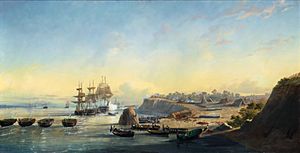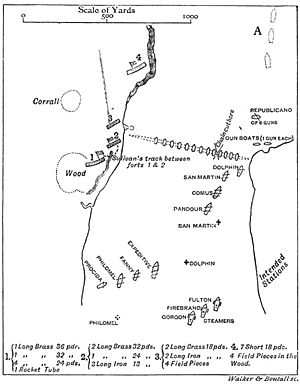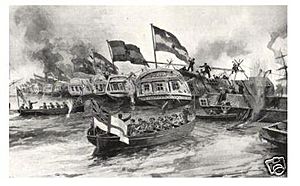Battle of Vuelta de Obligado facts for kids
Quick facts for kids Battle of Vuelta de Obligado |
|||||||
|---|---|---|---|---|---|---|---|
| Part of the Anglo-French blockade of the Río de la Plata | |||||||
 The Battle of Vuelta de Obligado, as depicted by François Pierre Barry |
|||||||
|
|||||||
| Belligerents | |||||||
| Commanders and leaders | |||||||
| Strength | |||||||
| 2160 men 4 coastal batteries 1 brigantine 2 gunboats |
11 warships | ||||||
| Casualties and losses | |||||||
| 150 killed 90 wounded 1 brigantine lost 21 cannons 20 barges |
28 killed 95 wounded Multiple damage to the warships, forcing emergency repairs. |
||||||
The Battle of Vuelta de Obligado was a major fight on the Paraná River in Argentina. It happened on November 20, 1845. This battle was between the Argentine Confederation, led by Juan Manuel de Rosas, and a strong fleet from Britain and France. It was part of a bigger event called the Anglo-French blockade of the Río de la Plata.
Even though the British and French ships managed to get past Argentina's defenses, the battle showed something important. It proved that foreign ships couldn't just sail through Argentina's rivers without permission. This fight also made many people in South America support Rosas and his government even more.
Contents
Why Did the Battle Happen?
During the 1830s and 1840s, the governments of Britain and France disagreed with Juan Manuel de Rosas. Rosas was the leader of the Argentine Confederation. He wanted all trade to go through the customs house in Buenos Aires. This helped him control the provinces along the coast. He also tried to include Paraguay and Uruguay in the Confederation.
These actions went against what Britain and France wanted for their trade. Rosas faced many problems with these foreign powers. Sometimes, these problems led to open fights. For example, there were two naval blockades: one by France in 1838, and another by Britain and France in 1845.
New Ships and Trade Routes
In the 1800s, new steam-powered ships were developed. These ships could travel up rivers quickly, even with heavy loads. This new technology allowed British and French ships to avoid Buenos Aires. They could sail directly into the La Plata Estuary and trade with cities further inland. These cities included those in Entre Ríos, Corrientes, Uruguay, and Paraguay.
This way, they avoided paying taxes in Buenos Aires. It also gave European traders special rights and allowed them to sell their goods cheaply.
Argentina's Response
Rosas's government tried to stop this practice. They announced that Argentina's rivers were closed to foreign ships. This meant foreign ships could not reach Paraguay or other ports. However, the British and French governments did not agree with this rule. They decided to challenge Rosas by sailing upriver with a joint fleet. This decision led directly to the Battle of Vuelta de Obligado.
The Battle Begins
The battle took place at a spot on the Paraná River called Vuelta de Obligado. The river here is about 700 meters wide. There is also a turn that makes it hard for ships to navigate.
Argentina's Defenses
Argentine General Lucio N. Mansilla was in charge of the Argentine forces. He was also Rosas's brother-in-law. General Mansilla set up a clever defense. He stretched three thick metal chains across the river. These chains were held up by 24 boats. The goal was to stop the enemy fleet from moving forward.
On the right side of the river, the Argentines placed four batteries with 30 cannons. These cannons were served by 160 gaucho soldiers. There were also 2,000 men in trenches. They were led by Colonel Ramón Rodríguez.
Argentina also had some naval vessels. These included the brigantine Republicano and two small gunboats, Restaurador and Lagos. Their job was to guard the chains across the river.
The Anglo-French Fleet
The British and French fleet had eleven warships. These ships were very advanced for their time. Some were steamers, which meant they used steam power. They also had some armor and fast-firing guns. Some even had Congreve rockets.
Here are some of the main ships in their fleet:
- British ships: Gorgon, Firebrand, Philomel, Comus, Dolphin, and the schooner Fanny.
- French ships: San Martin, Fulton, Expéditive, Pandour, and Procida.
The Main Fight
The battle started at dawn with heavy cannon fire and rockets from the British and French ships. The Argentine cannons were slower and less accurate. The Argentines suffered many losses early on. About 150 men were killed and 90 were wounded.
The boats holding the chains were burned. The Republicano brigantine was blown up by its own commander to prevent it from being captured. Some armed launches were also sunk. However, the gunboats Restaurador and Lagos managed to escape upriver.
Soon after, the French steamer Fulton found a gap in the broken chains. Troops from the fleet landed and attacked the remaining Argentine defenders on the bluff. The allied forces captured 21 cannons.
The Europeans had won passage up the river. They lost 28 men and had 95 wounded. However, their ships were badly damaged. They had to stay at Obligado for 40 days to make emergency repairs.
What Happened After the Battle?
Even though the British and French won the battle, they didn't fully achieve their goal. The severe damage to their ships and the loss of merchant ships showed something important. It would be too expensive and risky to sail Argentina's rivers without permission from the Argentine government.
Some Argentine leaders who were usually against Rosas were impressed by the battle. For example, General Martiniano Chilavert offered to join Rosas's army.
Eventually, France and the United Kingdom stopped their blockade. They gave up trying to bypass Buenos Aires's rules. They officially recognized Argentina's right to control the Paraná River and other internal rivers. In return, Rosas's army withdrew from Uruguay.
The Battle of Obligado is remembered in Argentina every year on November 20. This day was declared "Day of National Sovereignty" in 1974. It became a national holiday in 2010. There was even a subway station in Paris named Obligado for this battle. But in 1947, it was renamed Argentine as a friendly gesture after Eva Perón visited France.
Images for kids
See also
 In Spanish: Batalla de la Vuelta de Obligado para niños
In Spanish: Batalla de la Vuelta de Obligado para niños






